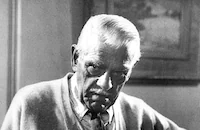The Mad Genius

Brief Synopsis
Cast & Crew
Michael Curtiz
John Barrymore
Marian Marsh
Charles Butterworth
Donald Cook
Luis Alberni
Film Details
Technical Specs

Synopsis
Club-footed Russian puppeteer Ivan Tsarakov is able to live his frustrated ambition to dance ballet through his protegé, Fedor Ivanoff. Tsarakov makes Fedor the greatest dancer in the world, even providing him with women. When Fedor falls in love with fellow dancer Nana Carlova, however, Tsarakov is convinced she will ruin him as a dancer. Consequently, he encourages the attentions of Count Renaud, hoping he will lure Nana away from Fedor, and when that fails, he fires Nana from the company. Fedor overhears Tsarakov talking to Nana and leaves with her. Together in Paris, the two lovers are happy at first, but as Tsarakov has informed all the ballet companies that Fedor is tied to an exclusive contract with him, Fedor is reduced to work in a cabaret. When Tsarakov's company opens in Paris, Nana begs him to give Fedor his job back. Tsarakov agrees on the condition that Nana leave Fedor for Renaud and she consents. Fedor is once again dancing, but he has become bitter and dictatorial. On opening night, he sees Nana in a box with Renaud and realizes that she still loves him. When he refuses to continue with the dance, Tsarakov threatens to kill him. Just before the curtain rises, ballet master Serge Bankieff, who is crazed by the drugs that Tsarakov supplies, kills Tsarakov. Liberated by Tsarakov's death, Fedor and Nana are reunited.

Director

Michael Curtiz
Cast

John Barrymore

Marian Marsh

Charles Butterworth

Donald Cook
Luis Alberni

Carmel Myers
Andre Luguet

Frankie Darro

Boris Karloff

Mae Madison
Crew

Videos
Movie Clip


Trailer
Film Details
Technical Specs

Articles
The Mad Genius
The picture received lavish production values, and Michael Curtiz was assigned to direct. (Svengali had been directed by Archie Mayo.) Working with art director Anton Grot and cameraman Barney McGill, Curtiz infused The Mad Genius with expressionistic angles and design that turned the film into a fascinating near-horror film, possibly inspired by the recent success of Dracula (1931) and other macabre thrillers. According to historian James C. Robertson (The Casablanca Man: The Cinema of Michael Curtiz), "the undisciplined Barrymore loathed Curtiz's strict direction and later reportedly compared it to participation in a marathon dance contest. In fact, he turned in one of his best sound performances amidst Anton Grot's fabulous, revolutionary theatre sets - tilted ceilings and floors, out of proportion doors and windows, and unusual staircases." It's worth noting, too, that The Mad Genius shows ceilings ten years before Citizen Kane (1941) was lauded for the same thing.
Still, the picture lost money at the box office (approximately $50,000), and with movie attendance way down in these early years of the Depression and most of Barrymore's previous films also money losers, Warner Brothers decided it could no longer justify the star's high salary - not to mention his refusal to properly publicize his films. Jack Warner terminated his contract and Barrymore left the studio after nearly ten years there, soon signing with MGM. (According to Barrymore family biographer James Kotsilibas-Davis, a story Jack Warner liked to tell around this time was how, when he was honored in Vienna, he was introduced as "the man who produces John Barrymore's movies," and the audience was silent. Then the toastmaster added, "Mr. Warner also produces the pictures of Rin Tin Tin," and the audience broke into applause.)
As for Curtiz, he was punished for distorting the studio's intentions with The Mad Genius by being assigned three inconsequential films with lesser studio stars: The Woman from Monte Carlo (1932), Alias the Doctor (1932) and The Strange Love of Molly Louvain (1932). Nonetheless, Curtiz made even these pictures quite stylish visually.
In one of his last roles before Frankenstein (1931), Boris Karloff has a small role in the opening scene as a child-abusing Russian father. He almost didn't get the part. When Karloff arrived at Curtiz's office after being summoned for an interview, Curtiz hesitated before saying, "Well, I called you over, so I suppose I'll have to use you." A few years later, when the star and director were working together again, Curtiz explained that he had asked to see Karloff because "I thought you actually were Russian. Your name certainly sounded Russian. When you came in, you seemed so anxious to get the job I decided to let you have it."
Variety praised Barrymore's performance as "a brilliant piece of acting, but the story lacks the quality that makes for wide human appeal... It is the actor's acting that takes the center of the screen, and not the human identity he plays, and that has been true of many of Barrymore's recent creations."
Director: Michael Curtiz
Screenplay: J. Grubb Alexander and Harvey Thew; Martin Brown (play "The Idol")
Cinematography: Barney McGill
Art Direction: Anton Grot
Film Editing: Ralph Dawson
Cast: John Barrymore (Vladimir Ivan Tsarakov), Marian Marsh (Nana Carlova), Charles Butterworth (Karimsky), Donald Cook (Fedor Ivanoff), Luis Alberni (Sergei Bankieff).
BW-81m.
by Jeremy Arnold

The Mad Genius
Quotes
Trivia
The play opened in Great Neck, New York, USA in 1929, and never made it to Broadway.
Notes
This was John Barrymore's last film for Warner Bros. According to modern sources, art director Anton Grot created a look similar to that of German Expressionist films. He used muslin ceilings on the sets, in contrast to the more usual practice of open ceilings to allow for easier lighting. Muslin ceilings were so uncommon that cinematographer Gregg Toland was applauded for their use in the 1941 film, Citizen Kane.















